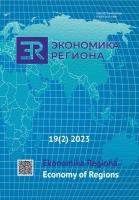Дифференциация малых городов по факторам локализации знаний
Differentiation of Small Towns by Knowledge Localisation Factors
Author(s): Tatyana Borisovna MelnikovaSubject(s): Economy, Geography, Regional studies, Rural and urban sociology, Socio-Economic Research
Published by: Институт экономики Уральского отделения Российской академии наук
Keywords: knowledge localisation; knowledge spillovers; small town; patent; infrastructure; knowledge exchange; agglomeration; specific knowledge; public knowledge; commercialisation; absorptive capacity;
Summary/Abstract: The ambiguity of the causal relationship between knowledge creation and regional growth does not indicate its insignificance, as proven by numerous empirical studies. However, such works rarely examine small towns, characterised by uncertainty of knowledge sources. The article aims to identify and compare groups of similar small towns in the Central, Ural and Southern Federal Districts by using a set of knowledge localisation factors. A two-stage clustering was performed by the k-means method according to the following criteria: interactions between actors, specific knowledge stock and financial resources for commercialisation. The resulting cluster centres were divided into quartiles according to the grading system (good, satisfactory or poor). First, the study revealed 10 clusters in the Central Federal District, 7 clusters in the Ural Federal District and 5 clusters in the Southern Federal District. In 35 % of the towns of the Southern Federal District, 35 % of the Central Federal District and 38 % of the Ural Federal District, the estimated specific knowledge stock exceeded the availability of financial resources. Second, towns were differentiated by population and divided into two groups depending on the agglomeration impact of larger cities. Clusters were formed within each group and federal district. 50 % of Ural towns with a population of 10,000 to 20,000 people unaffected by the agglomeration, as well as 62 % of towns with more than 20,000 people have the advantage of specific knowledge stock over financial resources. These values are 18 % and 8 %, respectively, for the Central Federal District, 36 % and 30 % for the Southern Federal District. The findings can help extend the analytical framework for making decisions on the small towns development. Future research may focus on establishing measures to improve the characteristics of clusters.
Journal: Экономика региона
- Issue Year: 19/2023
- Issue No: 2
- Page Range: 329-342
- Page Count: 14
- Language: Russian

